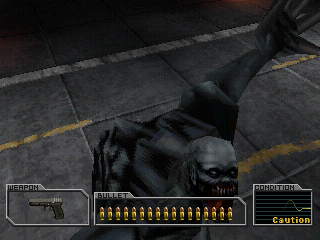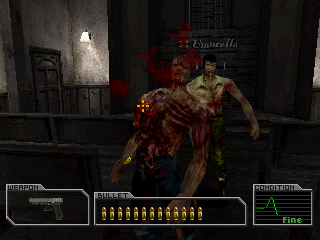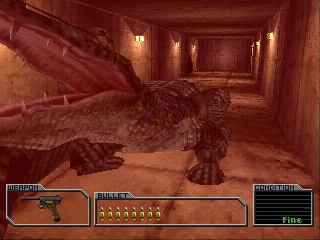Retro Replay Review
Gameplay
Resident Evil: Survivor marks a notable departure from the series’ traditional fixed-camera perspective by placing players squarely in the shoes of Ark Thompson in a first-person view. From the moment you awaken amid the wreckage of a crashed helicopter, the game thrusts you into exploration and combat that feel more immediate and visceral than its predecessors. Pressing the fire button toggles a targeting reticule, allowing for precise shots against hordes of shambling creatures. Although the pistol offers infinite ammunition, discovering scarce shells for shotguns and magnums adds a layer of resource management that will keep even seasoned players on edge.
(HEY YOU!! We hope you enjoy! We try not to run ads. So basically, this is a very expensive hobby running this site. Please consider joining us for updates, forums, and more. Network w/ us to make some cash or friends while retro gaming, and you can win some free retro games for posting. Okay, carry on 👍)
The level design leans heavily on tight corridors, dimly lit chambers, and surprise ambushes, reinforcing the tense atmosphere that has defined Resident Evil. Puzzles are integrated seamlessly into each stage—whether it’s finding a keycard behind a hidden vent or rotating valves to restore power—so progress never feels like busywork. The branching paths at the end of each level, presented as two doors leading to different subsequent stages, further enhance replay value. While all routes converge to a single climax, the feeling of choice encourages multiple playthroughs to uncover every secret.
Combat encounters strike a balance between fluid action and survival horror restraint. Melee attacks can knock enemies off balance, offering a momentary breather, but charging headlong into zombie-infested halls rarely ends well. The AI isn’t groundbreaking by modern standards—zombies lumber in predictable patterns and mutated beasts often telegraph their attacks—but the first-person perspective cleverly offsets these shortcomings by amplifying tension. Quick-time events aren’t a focus here; instead, the game relies on classic horror pacing and careful exploration to keep players invested.
Graphics
As the first Resident Evil title to employ fully real-time environments, Survivor showcases polygonal backdrops and character models that were ambitious for its time. Sheena Island’s decaying facility, overrun forests, and murky laboratories are rendered with a muted color palette that heightens the sense of dread. While textures can appear blurry up close, the overall art direction captures the bleak mood so well that minor technical limitations are easy to overlook.
Lighting plays a pivotal role in building tension. Flickering overhead bulbs cast long shadows, and the beam of your flashlight becomes both an ally and a vulnerability—enemies lurk just outside its reach. Particle effects, such as the swirl of dust motes in abandoned hallways or the spray of blood when a shotgun shell connects, add visceral impact to each encounter. Although polygon counts and draw distances are modest by today’s benchmarks, the game’s atmosphere remains potent thanks to careful scene composition.
Character models—including Ark Thompson himself, Umbrella personnel, and a menagerie of grotesque monstrosities—vary in fidelity. Ark’s animations can look stiff during transitions, but enemy movement is deliberately jerky, reinforcing their undead nature. Cut-scenes use in-engine cameras to heighten drama, offering dynamic angles that were a fresh departure for the series at release. While modern remakes have since leapfrogged these visuals, Survivor’s graphics still hold nostalgic charm and occasional jolts of genuine unease.
Story
The narrative thrust of Resident Evil: Survivor revolves around Ark Thompson, a nameless amnesiac who awakens to find only a pair of dog tags bearing his name, a pistol, and the wreckage of a helicopter. As he navigates Sheena Island’s decimated research outposts, Ark’s journey alternates between unraveling his own identity and exposing Umbrella Corporation’s sinister biological weapons experiments. While the plot doesn’t carry the same emotional punch as earlier Resident Evil entries, it offers enough mystery to drive players deeper into the island’s bowels.
Dialogue is functional and sparse, delivered through on-screen text and brief cut-scenes. Characters Ark encounters—ranging from panicked survivors to calculating Umbrella agents—serve primarily as narrative anchors, steering him toward key objectives rather than sharing in-depth backstories. Despite this, small details, such as journal entries and audio logs, flesh out the stakes and hint at Umbrella’s broader machinations. The story culminates in a tense showdown that ties back into the series’ established timeline without feeling tacked-on.
Branching level paths also feed into the storytelling by revealing unique set pieces and optional lore fragments. Whether you investigate a submerged lab or penetrate a high-security vault, each detour deepens the island’s tragic history. Although the script occasionally leans on genre clichés—panicked screams echoing in hallways, shadowy figure sightings—the compact narrative remains coherent and suitably creepy for fans seeking classic survival horror thrills.
Overall Experience
Resident Evil: Survivor is a bold experiment that trades the series’ trademark cinematic framing for an in-your-face first-person perspective. This shift may jar purists expecting the careful camera work of earlier titles, but it rewards those willing to embrace its leaner, more action-oriented approach. The balance of exploration, puzzle-solving, and monster encounters ensures pacing rarely stalls, keeping you on your toes from the opening crash site to the climactic escape sequence.
Replayability is a standout feature. The choice of two doors at the end of each level quickly multiplies potential routes, encouraging multiple runs to uncover all hidden areas and item caches. Collectible materials and weapon upgrades feel meaningful, especially when facing tougher mutants and bosses on return trips. While the narrative may not redefine the series’ lore, the gameplay loop provides enough variation to merit several playthroughs for completionists and casual fans alike.
Ultimately, Resident Evil: Survivor offers a different flavor of Umbrella-induced terror—one that emphasizes immediacy over cinematic buildup. Its graphics and controls show their age, but for those intrigued by branching levels, resource management, and a first-person twist on classic Resident Evil motifs, it remains a worthwhile expedition into the franchise’s dark underbelly. Purchase this for a refreshing, if sometimes rough-around-the-edges, survival horror ride that slots neatly into the larger Resident Evil saga.
 Retro Replay Retro Replay gaming reviews, news, emulation, geek stuff and more!
Retro Replay Retro Replay gaming reviews, news, emulation, geek stuff and more!









Reviews
There are no reviews yet.